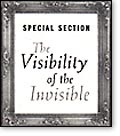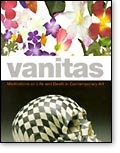Daniel A. Siedell
The Visibility of the Invisible: The Artworld's Memento Mori

Special Section

Vanitas
Vanitas: Meditations on Life and Death in Contemporary Art, by John B. Ravenal, Virginia Museum of Fine Arts/University of Washington Press, 68 pp.; $18.95, paper
Most historical narratives of twentieth century art have, in various ways, accepted as a truism some version of the secularization theory advanced by sociologists, which regards modernity as incompatible with religious belief or spirituality. If, as Ezra Pound insisted, artists are "the antennae of the race," it follows that this incompatibility will be expressed with particular clarity in modern art—and so the common wisdom assures us.[1] Whether or not this perspective is an accurate portrait of modernity (and the recent retreat from secularization theory by some of its principal advocates raises that question pretty forcefully), there is no doubt that spirituality and religious belief are alive and well in our "postmodern" culture—and so also in the contemporary artworld. But while contemporary artists have been exploring spirituality and religious belief aesthetically, art historians, art critics, and curators have paid little attention, so one must look a bit closer to find the evidence.
One place to look is a modest exhibition catalogue that accompanied an exhibition organized by the Virginia Museum of Fine Arts. Entitled Vanitas: Meditations on Life and Death in Contemporary Art, this exhibition was on display at the Virginia Museum of Fine Arts from April 4-June 28, 2000 and featured the work of 14 artists. Far from being reactionary or rear-guard figures working on the margins, these are some of the most important con temporary artists, including Christian Boltanski, Robert Gober, the late Felix Gonzalez-Torres, Anish Kapoor, Zoe Leonard, and Gabriel Orozco.
The exhibition's curator and author of the catalogue essay, John B. Ravenal, ex presses his own surprise at the intensity with which many contemporary artists are pursuing spiritual issues in their art. Ravenal quotes Robert Gober, who in a recent interview asserted that he is concerned to make a religious art or art that "is made with God in mind—like an at tempt to understand the mysteries of faith." Al though the pieces gathered for this exhibition are not explicitly "religious art," Vanitas explores the artist's recognition of art's capacity to communicate the spiritual dimension of life and death.
"Vanity of vanities, saith the Preacher, vanity of vanities; all is vanity." So reads the epigraph of the catalogue essay, and the wisdom of Ecclesiastes remains an important subtext for the exhibition, even while Ravenal steers the art away from the context of divine revelation. For the author/ curator, the vanitas tradition focuses on one of life's fundamental tensions, between the enjoyment of earthly pleasures and accomplishments and awareness of inevitable loss. Although it is found in various manifestations through out the history of Christian art in Western Europe since the fourteenth century, the vanitas or memento mori theme inspired virtually a distinct genre in seventeenth century Dutch still-life painting, which played an important role in the visual culture of Northern European Calvinism. Ravenal finds this traditional artistic theme in unexpected places in the contemporary artworld: plastic bottles filled with water dyed red and hanging from a suspended rope, a pair of ice skates, a pair of synchronized wall clocks, silicone rubber, sewn dried orange and banana peels, and a decorated skull.
Ravenal is a bit too quick to attribute contemporary artists' profound interest in exploring life and death in their art to pressing global issues and "conflict and crisis [which] are hallmarks of contemporary life." At what time in human history has such reflection been irrelevant? And indeed, his catalogue essay attempts to find continuities between and among some of the most challenging contemporary artworks and the more traditional art of the past. The exhibition, which focuses on sculpture and installation art, differs from the more traditional manifestations of the vanitas theme, Ravenal suggests, insofar as these works of art "physically embody their themes in their materials, process, and forms in contrast to the pictorial representation of ideas in painting or photography."
Consider, for example, one of the most explicit references to the vanitas tradition: the 1997 work Black Kites, by Mexican artist Gabriel Orozco (b. 1962), an artist known for his subtle compositions, whether installations, photographs, or sculptures, and his use of ordinary materials, whether a garden hose or a partially deflated soccer ball filled with water. Lent to the exhibition from the permanent collection of the Philadelphia Museum of Art, Black Kites is a human skull covered in graphite patterns of diamond-shaped kite forms.
The skull is the classic symbol in the Western tradition of the transience of life. Instead of representing a skull, Orozco draws directly onto an actual human skull, decorating it with patterns that allude both to the Harlequin costume and the chessboard, evoking the game of life and its rules. Orozco downplays the potential morbidity of an actual human skull serving as a drawing surface through his sensitive application of the diamond shapes, which suggests an intimate—even meditative—tactile experience of and relationship to this human skull, as an aesthetic manifestation of the artist's reflection on life and death.
The massive media coverage devoted to certain recent "sensational" exhibitions has reinforced in the public mind the already well-established image of a viciously anti-spiritual and anti-religious contemporary artworld. The reality is much more complex. Spiritual and religious issues re main important for a vast number of contemporary artists. This modest project demonstrates that contemporary artists, like their predecessors, "address some of the basic conflicts of human existence, between presence and absence, pleasure and fear, love and loss, power and instability, beauty and death." Vanitas also shows that, contrary to its dismissive critics, contemporary art is not devoid of beauty—with the understanding that beauty is ephemeral. "Vanity of vanities . …"
Daniel A. Siedell is curator of the Sheldon Memorial Art Gallery and Sculpture Garden at the University of Nebraska.
Footnote:
1. There have been notable exceptions to this consensus; see, for example, The Spiritual in Art: Abstract Painting 1890-1985, by Maurice Tuchman et al. (Los Angeles County Museum of Art/Abbeville Press, 1986).
NOTE: For your convenience, the following product, which was mentioned above, is available for purchase:
• Vanitas, John B. Ravenal
Copyright © 2001 by the author or Christianity Today/Books & Culture Magazine.
Click here for reprint information on Books & Culture.








No comments
See all comments
*